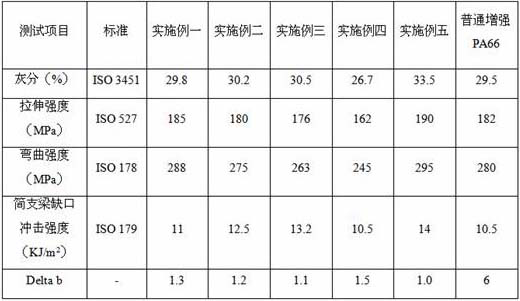A kind of anti-yellowing reinforced nylon 66 material and preparation method thereof
A technology of anti-yellowing and nylon, applied in the field of polymers, can solve the problems of damaging the high strength of nylon 66, difficult to disperse uniformly, and limited effect, and achieve the effect of inhibiting oxidative discoloration and solving easy yellowing
- Summary
- Abstract
- Description
- Claims
- Application Information
AI Technical Summary
Problems solved by technology
Method used
Image
Examples
Embodiment 1
[0028] Stir and mix 1.2kg of maleic anhydride, 0.5kg of sodium phosphate and 0.5kg of silane coupling agent KH550 evenly, add 10000ml of ethanol to disperse alcoholysis, adjust the pH value of the solution to 3.2, and obtain a special slurry for processing glass fiber; then mix 48kg of The alkali glass fiber is infiltrated with special slurry and dried to obtain surface-treated special glass fiber; add 100kg of nylon 66, 10kg of nylon 612 and 0.5kg of antioxidant 1098 into a low-speed mixer and mix evenly. Add a small amount of white oil for adhesion to obtain a premix; finally add the premix to the main feeding bin of the twin-screw extruder, add the treated special glass fiber through side feeding, and the extrusion temperature is 240 Between ℃; pull rods, cool and cut into pellets. Dry the particles in an oven at 80°C for 5 hours, then inject standard ISO sample strips and standard swatches, and then bake the standard swatches in an oven at 140°C for 4 hours to test the b v...
Embodiment 2
[0030] Stir and mix 1kg of acrylic acid monomer, 1kg of iron phosphate and 0.5kg of silane coupling agent KH550 evenly, add 10000ml of ethanol to disperse alcoholysis, adjust the pH value of the solution to 3.8, and obtain a special slurry for processing glass fiber; then pass 53kg of glass fiber through The special slurry is infiltrated and dried to obtain the surface-treated special glass fiber; 100kg of nylon 66, 20kg of nylon 610, 0.5kg of antioxidant 1098, and 0.5kg of antioxidant 445 are added to a low-speed mixer and mixed evenly. During the process, a small amount of white oil is added for adhesion to obtain a premix; finally, the premix is added to the main feeding bin of the twin-screw extruder, and the treated special glass fiber is added through side feeding, and the extrusion temperature Between 270°C; pull strips, cool, and cut into pellets. Dry the particles in an oven at 80°C for 5 hours, then inject standard ISO sample strips and standard swatches, and then ...
Embodiment 3
[0032] Stir and mix 1.5kg of maleic anhydride, 1.5kg of calcium phosphate and 0.5kg of silane coupling agent KH550 evenly, add 10000ml of ethanol to disperse alcoholysis, adjust the pH value of the solution to 3.2, and obtain a special slurry for processing glass fiber; then mix 58kg of glass The fibers are infiltrated with special slurry and dried to obtain surface-treated special glass fibers; 100kg of nylon 66, 30kg of nylon 1012 and 0.5kg of antioxidant 1098 are added to a low-speed mixer and mixed evenly. During the mixing process, a small amount of The white oil is adhered to obtain the premix; finally, the premix is added to the main feeding bin of the twin-screw extruder, and the treated special glass fiber is added through side feeding, and the extrusion temperature is above 240°C Between; strips, cooled, diced. Dry the particles in an oven at 80°C for 5 hours, then inject standard ISO sample strips and standard swatches, and then bake the standard swatches in an ov...
PUM
 Login to View More
Login to View More Abstract
Description
Claims
Application Information
 Login to View More
Login to View More - R&D
- Intellectual Property
- Life Sciences
- Materials
- Tech Scout
- Unparalleled Data Quality
- Higher Quality Content
- 60% Fewer Hallucinations
Browse by: Latest US Patents, China's latest patents, Technical Efficacy Thesaurus, Application Domain, Technology Topic, Popular Technical Reports.
© 2025 PatSnap. All rights reserved.Legal|Privacy policy|Modern Slavery Act Transparency Statement|Sitemap|About US| Contact US: help@patsnap.com

